The Intel Skull Canyon NUC6i7KYK mini-PC Review
by Ganesh T S on May 23, 2016 8:00 AM ESTGaming Benchmarks
Intel's Iris Pro Graphics SKUs with integrated EDRAM are amongst the highest-performing iGPUs in the market right now. The Core i7-6770HQ is equipped with Intel Iris Pro Graphics 580 - a GT4e part with 72 EUs and 128MB of eDRAM.
For the purpose of benchmarking, we chose six different games (Sleeping Dogs, Tomb Raider, Bioshock Infinite, The Talos Principle, GRID Autosport and DiRT Showdown) at various quality levels. The purpose of this section is not to benchmark the latest and greatest games, or benchmark at 4K resolutions. Intel clearly targets the Skull Canyon NUC towards casual gamers and those wanting to get introduced to mainstream gaming titles. As such, it is expected that people would play games with medium settings at 1080p or lower resolutions.
Sleeping Dogs
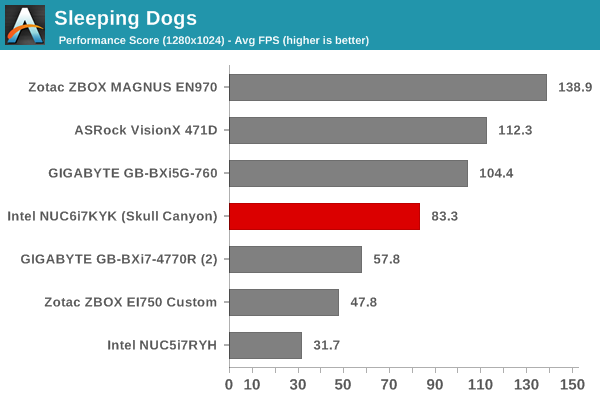
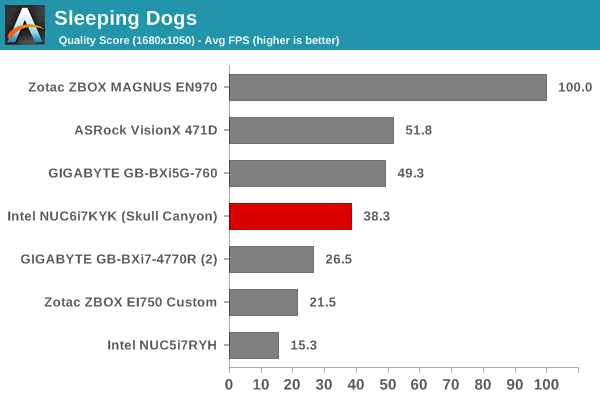
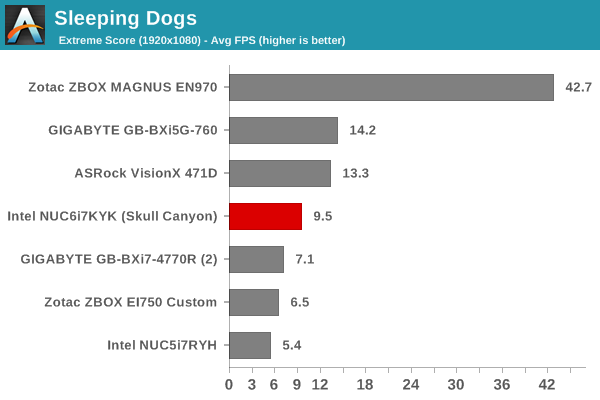
Tomb Raider

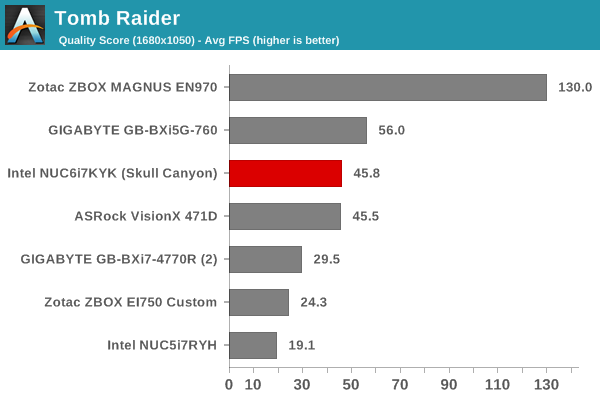
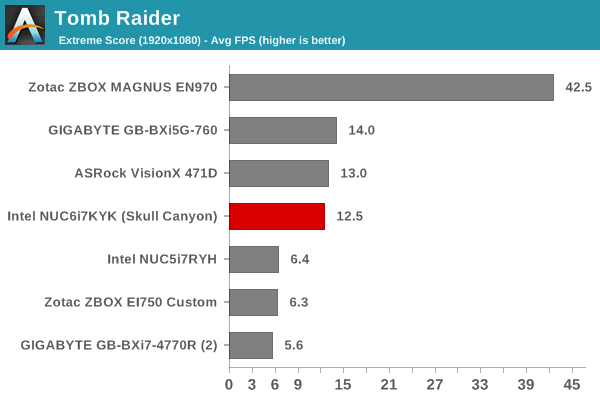
Bioshock Infinite
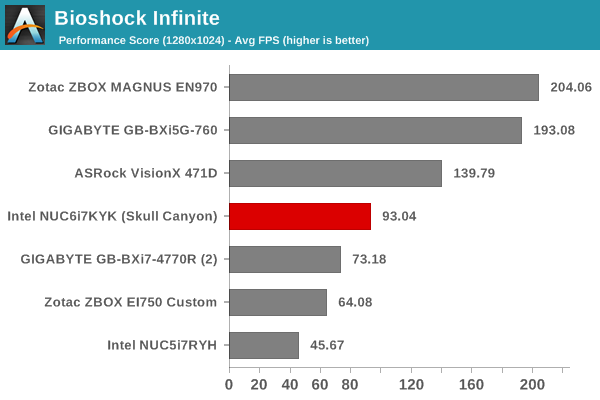
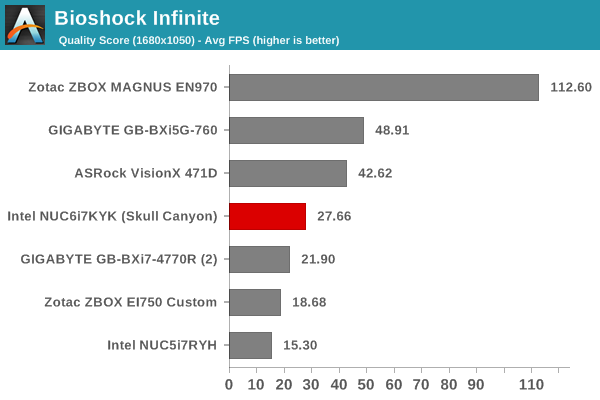

DiRT Showdown
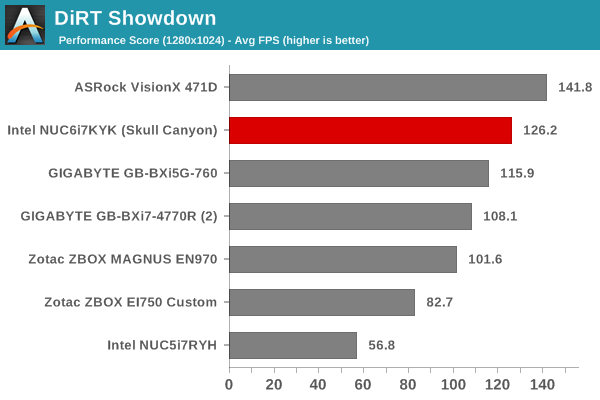
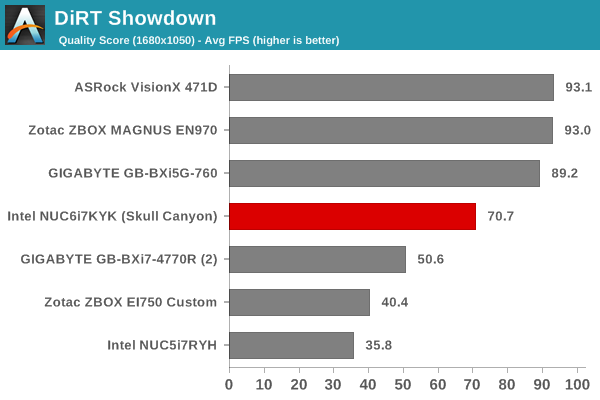
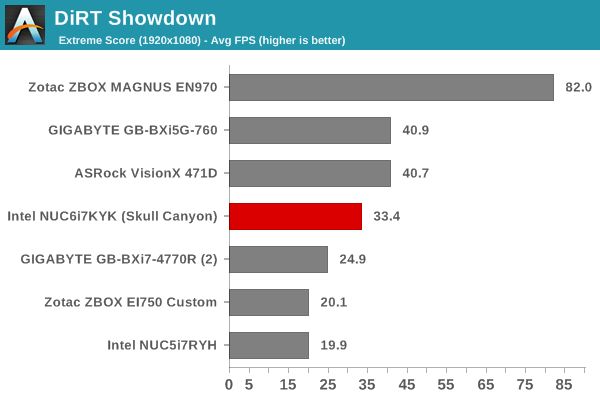
The Talos Principle
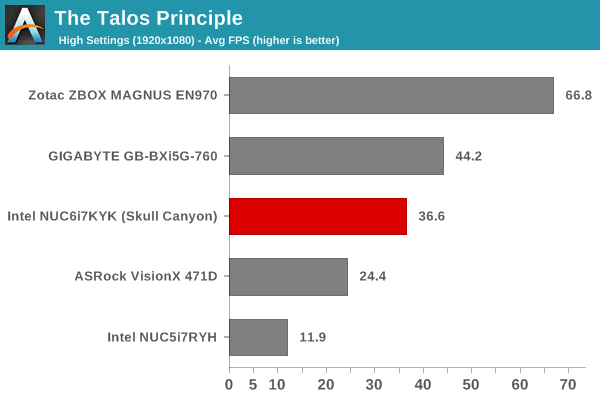
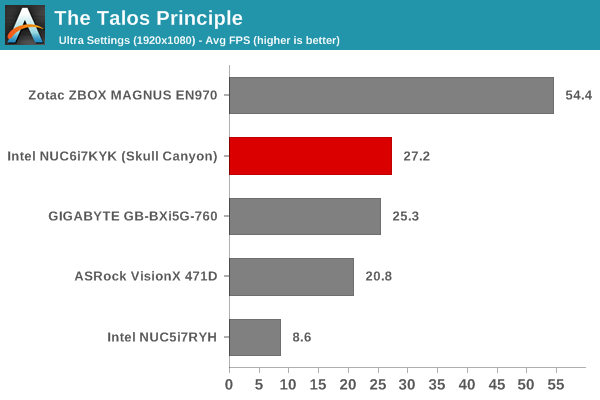
GRID Autosport
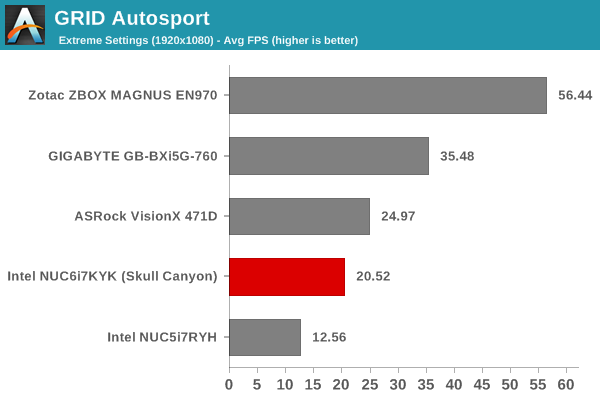
All the numbers point to expected results - Skull Canyon is simply the best when it comes to having the best iGPU for gaming purposes. However, it is a bit of a disappointment when compared to systems having slightly bigger footprints, but, equipped with previous generation discrete mobile GPUs. An external Thunderbolt GPU dock can solve some of the issues for users wanting more graphics prowess than what the Iris Pro Graphics 580 can deliver, but that has a significant price premium, and it is not something that we evaluated as part of this review.










133 Comments
View All Comments
ragenalien - Monday, May 23, 2016 - link
Could we get a comparison between this and the iris pro 6200? Seems like there isn't much difference performance wise, but there should be.defaultluser - Monday, May 23, 2016 - link
Skylake gets much better GPU performance/watt than Broadwell did, as evidenced by the NUC with 48 EU 64MB eDRAM being fed by just 23w continuous. That's a huge improvement form the 45w this beast used to take!I think the only surprise for me was just 40% performance improvement over the 4770r. I always assumed the 4770r was bandwidth-limited, but I guess the eDRAM cache was enough to keep things fed.
But yeah, pointless product continues to be pointless. Intel charges a premium for these things because they take up more die space and require dedicated eDRAM cache to feed them...just like discrete GPUs take up more die space, and require dedicated DRAM to feed them. Where is the efficiency gain in this crap?
defaultluser - Monday, May 23, 2016 - link
Oh, I just noticed the review uses 2133 DDR4, which would account for the 40% performance increase we saw. I thought for sure a "premium gaming" platform like this would ship with z170, so I didn't give the test setup a second glance.I guess Intel cheaping-out with H170 has forever doomed this machine to mediocrity. Too bad, dropping ten bucks more on the Z170 would have allowed some much more interesting memory configurations. With DDR4 2133 we're probably castrating performance.
tipoo - Monday, May 23, 2016 - link
"Our only concern is that the cooling solution keeps the temperature of the cores too close to the junction temperature during periods of heavy CPU load."My rMBP 15", Iris Pro only model, routinely hovers at the tJunction max at load. Is this a real concern? Or is it designed to do this?
BrokenCrayons - Monday, May 23, 2016 - link
There's probably a little wiggle room built into the processor's design by its engineers, but according to Intel's site here: http://www.intel.com/content/www/us/en/support/pro..."Tjunction Max is the maximum temperature the cores can reach before thermal throttling is activated. Thermal throttling happens when the processor exceeds the maximum temperature. The processor shuts itself off in order to prevent permanent damage. Tjunction Max (Tj Max) is also referred to as TCC Activation Temperature in certain processor datasheets."
Basically, reaching the Tjunction means the CPU is close to shutting itself off to prevent damage. That might mean there are longevity implications related to brushing up against that upper ceiling on a regular basis, but I haven't seen any statistical data regarding a meaningful sample of processors put under such conditions failing more often during their few years of useful life due to CPUs going bad just because the OEM decided to implement a cooling solution that allows the processor to wander up to the Tjunction temp when it's working hard.
I think a bigger concern might be looking into whether or not the rMPB in general will approach Tjunction under load or if that's abnormal. Abnormalities might point to some sort of problem with your specific laptop. I don't know what's status quo for your hardware so its hard to say if that's something you should worry about.
tipoo - Monday, May 23, 2016 - link
Yeah, that's something I looked into, Anandtechs own retina macbook pro 15" review only pegged them at going up to 76 ish celsius if memory serves, but that was the older dGPU model with the 650M. From the threads I'm seeing, the Iris Pro model does regularly hover at 99-101C, I'm guessing since the GPU grunt is right beside the CPU on a single die so heat isn't spread wider like the dedicated GPU model.I don't see any reports of this model failing though, so I'd hope they tested extensively at 100 degrees and found it was fine, and so allowed the processor to keep its boost long enough to get there.
I do wish they could have just added another few mm so that the cooling was better and the CPU and GPU could stay at boost longer, and with that room they could have added some mm to the keyboard too (which I consider the absolute minimum in key travel now).
tipoo - Monday, May 23, 2016 - link
Plus they also only tested Half Life 2, which probably allowed the CPU and GPU not to be at max all the time as it's so old.8steve8 - Monday, May 23, 2016 - link
give us a 65W CPU with iris pro , add a couple inches in height... and use the stock retail CPU cooler. Add USB-c in the front. Use USB power delivery usb-c for power.Done, the perfect little pc.
TheinsanegamerN - Monday, May 23, 2016 - link
Except the niche NUCs fill dont want a NUC the size of a MINI-ITX case. Not to mention intels stock cooler is not the quietest nor the best cooler in existence.8steve8 - Monday, May 23, 2016 - link
well a couple inches of height would not put it near the average mini-itx case size.It's impressive that these NUCs are small, but they goes a bit extreme when they use laptop chips and cooler designs meant for laptops. We can get a very small desktop without sacrificing CPU performance and acoustics/thermals.
Use 65W+ chips w/iris pro, full size intel retail heatsink, usb-c power delivery... no wasted space with expansion slots. 1 m.2 should be the only internal slot.